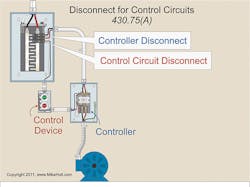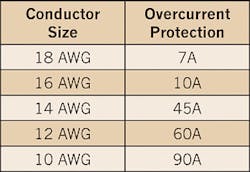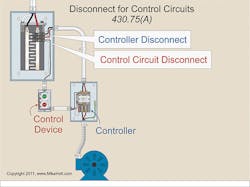All questions and answers are based on the 2011 NEC.
Q. What is the Code rule for motor control circuit overcurrent protection?
A. Motor control conductors that aren’t tapped from the branch circuit protective device are classified as a Class 1 remote-control circuit, and they must have overcurrent protection in accordance with 725.43 [430.72(A)]. This section of the Code states that overcurrent protection for conductors 14 AWG and larger must comply with the conductor ampacity from Table 310.15(B)(16). Overcurrent protection for 18 AWG must not exceed 7A, and a 10A device must protect 16 AWG conductors.
Motor control circuit conductors tapped from the motor branch circuit protection device that extends beyond the tap enclosure must have overcurrent protection, as shown in the Table.
The above limitations don’t apply to the internal wiring of industrial control panels listed in UL 508, Standard for Practical Application Guidelines.
Transformers for motor control circuit conductors must have overcurrent protection on the primary side in accordance with 430.72(C)(1) through (6) [430.72(C)]. Many control transformers have small iron cores, which result in very high inrush (excitation) current when the coil is energized. This high inrush current can cause standard fuses to blow, so you should only use the fuses recommended by the control transformer manufacturer.
If physical damage would result in a hazard, the conductors of a remote motor control circuit installed outside the control device must be protected by installing the conductors in a raceway or be protected from physical damage [430.73].
Motor control circuit conductors must have a disconnecting means that simultaneously opens all sources of supply when the disconnecting means is in the open position [430.75(A)]. If the control circuit conductors are tapped from the controller disconnect, the controller disconnecting means can serve as the disconnecting means for the control circuit conductors [430.102(A)].
If the control circuit conductors aren’t tapped from the controller disconnect, a separate disconnecting means is required for the control circuit conductors, and it must be located adjacent to the controller disconnect (see Figure).
Q. What are the rules on the use of expansion fittings for a PVC raceway?
A. If PVC conduit is installed in a straight run between securely mounted items, such as boxes, cabinets, elbows, or other conduit terminations, expansion fittings must be provided to compensate for thermal expansion and contraction of the raceway in accordance with Table 352.44, if the length change is determined to be ¼ in. or greater [352.44].
Table 352.44 was created based on the following formula:
Expansion/Contraction Inches = Raceway Length ÷ 100 × [(Temp Change ÷ 100) × 4.00]
Here’s a sample calculation to show you how to apply this in the real world.
How much will a 25 ft run of PVC conduit contract when it’s located in an ambient temperature change of 25°F?
Expansion/Contraction Inches = (25 ÷ 100) × [(25 ÷ 100) × 4.00] = 0.25 in.
About the Author

Mike Holt
Mike Holt is the owner of Mike Holt Enterprises (www.MikeHolt.com), one of the largest electrical publishers in the United States. He earned a master's degree in the Business Administration Program (MBA) from the University of Miami. He earned his reputation as a National Electrical Code (NEC) expert by working his way up through the electrical trade. Formally a construction editor for two different trade publications, Mike started his career as an apprentice electrician and eventually became a master electrician, an electrical inspector, a contractor, and an educator. Mike has taught more than 1,000 classes on 30 different electrical-related subjects — ranging from alarm installations to exam preparation and voltage drop calculations. He continues to produce seminars, videos, books, and online training for the trade as well as contribute monthly Code content to EC&M magazine.


